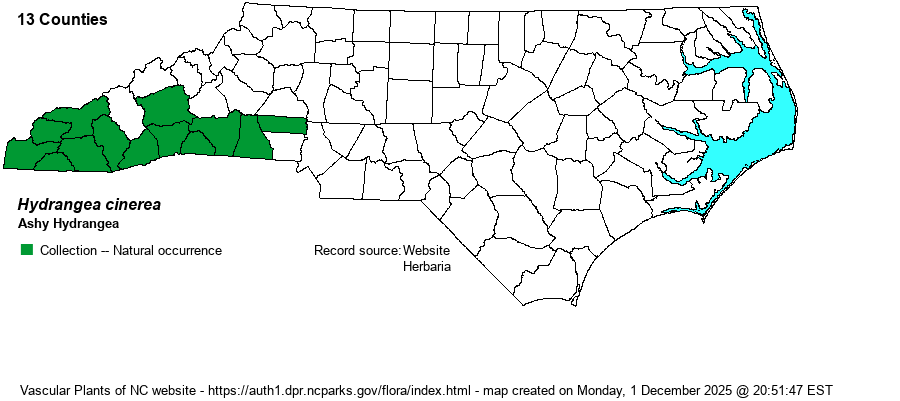| Author | Small | |
| Distribution | Restricted to the southern half of the Mountains and the southwestern Piedmont, ranging north and east to Buncombe and Lincoln counties.
This is primarily a Midwestern species, with a center of distribution around western KY and western TN. It ranges east only to southwestern NC, and south to northern GA and southern AL; then west to eastern OK and north to IL and IN.
| |
| Abundance | Rare to uncommon in its fairly small range in the state. This is the only one of the three Hydrangea species in the state that is scarce enough to be on the NC NHP Watch List. | |
| Habitat | This species is limited to rocky and rather cool forested sites. It favors shaded bluffs, rocky ravines, moist roadbanks, and other such moist sites, apparently limited to mafic rocks (i.e., circumneutral soil). | |
| Phenology | Blooms and fruits in May and June. | |
| Identification | This is a species that was formerly considered as a subspecies or variety of Hydrangea arborescens, and is therefore quite similar in overall proportions, being a deciduous shrub growing to 5-6 feet tall. It has large, opposite leaves with rather long petioles and a widely ovate shape with a narrow tip. It can be separated from H. arborescens strictly by the leaf undersides. Ashy Hydrangea has leaves that are grayish or ashy-colored below and not medium green; the considerable hairs below do not completely obscure the green color, unlike on H. radiata, which has whitish to silvery leaf undersides. | |
| Taxonomic Comments | RAB (1968) and some other references considered this taxon as a subspecies of H. arborescens, whereas some others listed it as a variety. In fact, as a subspecies it was named as H. arborescens ssp. discolor.
| |
| Other Common Name(s) | Gray Hydrangea | |
| State Rank | S2 [S2S3] | |
| Global Rank | G5 | |
| State Status | W7 [W1] | |
| US Status | | |
| USACE-agcp | | |
| USACE-emp | | |

